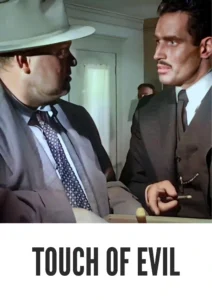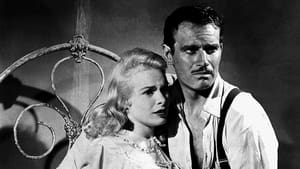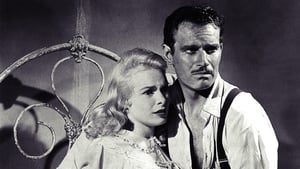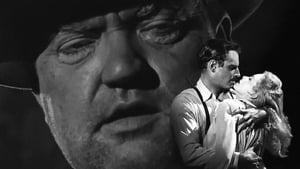Video Sources 0 Views

Synopsis

Step into the morally ambiguous world of Touch of Evil, Orson Welles’s compelling 1958 border-town crime drama, now vividly colorized to amplify its dark atmosphere and gripping tension. This film, starring Welles and Charlton Heston, plunges into the depths of corruption, racial prejudice, and the abuse of power. Perfect for fans of intense thrillers and those drawn to Welles’s directorial genius, this HD download offers a fresh perspective on a cinematic masterpiece.
Touch of Evil unfolds in a seedy border town where a car bomb ignites a chain of events that tests the limits of justice and morality. Miguel “Mike” Vargas (Charlton Heston), a respected Mexican drug enforcement official, and his new American wife, Susie (Janet Leigh), find themselves entangled in the investigation led by the corrupt and imposing police captain, Hank Quinlan (Orson Welles).
As Vargas begins to unravel the truth behind the bombing, he clashes with Quinlan, whose methods are anything but ethical. Quinlan resorts to planting evidence and manipulating witnesses to secure his version of justice, leading to a fierce confrontation between the two men. Susie becomes a target of Quinlan’s web of deceit, further escalating the tension. The film delves deep into themes of racial tension, moral decay, and the seductive nature of power, culminating in a suspenseful showdown that exposes the dark underbelly of the border town. Touch of Evil is a cinematic exploration of how good intentions can be corrupted and how the pursuit of justice can blur the lines of right and wrong.
Touch of Evil features a stellar cast, each contributing to the film’s intense and unforgettable atmosphere:
-
Orson Welles as Hank Quinlan
-
Charlton Heston as Miguel “Mike” Vargas
-
Janet Leigh as Susan “Susie” Vargas
-
Akim Tamiroff as Uncle Joe Grandi
-
Marlene Dietrich as Tanya
Touch of Evil transcends simple genre classification, blending elements of crime thriller, film noir, and suspense to create a uniquely compelling cinematic experience. Its dark themes, morally complex characters, and striking visual style solidify its place as a landmark film.
Released in 1958, Touch of Evil is considered by many to be one of Orson Welles’s finest directorial achievements and a significant work in the film noir tradition, even though it arrived towards the end of the classic noir cycle. Welles’s innovative use of camera angles, long takes, and deep shadows creates a visually stunning and unsettling atmosphere that perfectly complements the story’s themes of corruption and moral decay. The film reflects the anxieties and social tensions of the Cold War era, exploring the abuse of power and the erosion of individual rights. Despite initial mixed reviews and studio interference, Touch of Evil has since been recognized as a masterpiece of cinematic art, influencing countless filmmakers and solidifying Welles’s reputation as a visionary director.
This colorized version of Touch of Evil offers a reimagined viewing experience, enhancing the film’s visual impact while preserving its original atmosphere. The colorization process involved meticulous attention to detail, with careful consideration given to the film’s lighting, set design, and costume choices. Modern digital techniques were employed to bring the grayscale tones to life, adding depth and richness to the visuals. While the specific tools used remain proprietary, the color enhancement was achieved through advanced algorithms, ensuring a seamless and immersive viewing experience. This painstaking process introduces a new dimension to the story, making it even more accessible and engaging for contemporary audiences, while honoring the artistic integrity of the original film.
-
: Orson Welles
-
: Orson Welles (uncredited), based on the novel Badge of Evil by Whit Masterson
-
: Russell Metty
-
: Virgil Vogel, Aaron Stell
-
: Universal International Pictures
-
: Universal Pictures
-
: 95 minutes (111 minutes, restored version)
-
: MP4
-
: HD (1080p)
-
: Compatible with most devices, including smartphones, tablets, computers, and smart TVs.
Touch of Evil (1958) has garnered widespread critical acclaim over the years, solidifying its status as a cinematic masterpiece. Its innovative direction, compelling performances, and thought-provoking themes have resonated with audiences and critics alike. Often praised for its visual style, the film’s long takes, deep shadows, and unusual camera angles create a sense of unease and tension that perfectly captures the story’s dark atmosphere. As a landmark film in the noir tradition, Touch of Evil continues to be studied and celebrated for its artistic merit and its enduring influence on cinema.
-
: What is Touch of Evil about?
-
A: Touch of Evil is a crime thriller about a Mexican drug enforcement official who clashes with a corrupt American police captain in a border town.
-
-
: Why is Touch of Evil (1958) considered a classic?
-
A: Touch of Evil is celebrated for its innovative direction, compelling performances, and thought-provoking themes, making it a landmark film in the noir tradition.
-
-
: Is this version of Touch of Evil colorized?
-
A: Yes, this version has been professionally colorized to enhance the viewing experience.
-
-
: What makes Touch of Evil interesting for film enthusiasts?
-
A: Touch of Evil showcases Orson Welles’s directorial genius and offers a compelling exploration of corruption, morality, and the abuse of power.
-
-
: What is the download format?
-
A: The download format is MP4, which is compatible with most devices.
-
-
: What resolution is the download?
-
A: The resolution is HD (1080p), providing a high-quality viewing experience.
-
Experience Touch of Evil Today!















